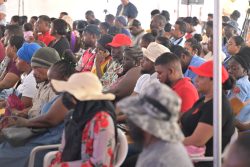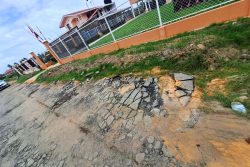Dear Editor,
It is now two years since the APNU regime took power in Guyana. During that period, we have seen a major decline in our economy, the erosion of civil and political liberties, the transformation of our National Assembly from being a forum for debate and discussion into a rubber-stamp where debates are stifled, etc.
In the face of these reversals the regime’s propaganda machinery, in tandem with some in the private media, is desperately attempting to sell the view that things were worse under the PPP/C administration; that this APNU regime inherited a bad situation. It is, therefore, necessary to remind everyone what the conditions were that prevailed at the time the PPP/C demitted office.
Guyana was a country on the rise. Under the PPP/C administration, we had the fastest growing economy in the region. Indeed, we had become a beacon of hope for the Caribbean. From 2006-14, Guyana’s economy experienced continuous, positive growth under the PPP/C administration. This was the longest period of uninterrupted growth in the history of independent Guyana. The average growth rate was 4.5% per annum.
In 2014, the last full year of the PPP/C in office, Guyana’s GDP was US$3.1 billion. That was up from US$1.4 billion in 2006, an increase of 121.4%. Our country’s Gross International Reserve held at the Bank of Guyana at the end of 2014 was US$665.6 million, which was equivalent to 3.6 months of imports. It was up from US$251.4 million in 2005, an increase of 164.76%.
The PPP/C administration had drastically reduced the huge debt it had inherited from a previous PNC regime. The PPP/C reduced the external debt to just 39.5% of GDP. What a turnaround! That was also a reduction from 2006 when the debt to GDP was 71.8%. This is a demonstration of the good financial management by the PPP/C and the dynamic growth of the economy.
At the end of 2014, the total assets held at commercial banks were $421.8 billion. This was an increase of 159.3% over 2005, when total assets were $162.7 billion. The commercial banks were, therefore, in a position to provide substantial credit to the private sector. In 2014, $202 billion was given as credit, compared to just $52.4 billion in 2005. This was an increase of 285.5%, which tells the story of a vibrant private sector. The interest rates were becoming much more favourable to those borrowing. They had declined to 10.8% at the end of 2014, from 13.5% in 2005 and more than 35% in 1992.
At the same time, our exchange rate was very stable. It was $206 to US$1.00 in 2014, compared to $200.25 to US$1 in 2005. These figures, however, do not tell the whole story. The strides were made in a very hostile environment by the political opposition. One must recall the riots and destruction by fire after the 1992, 1997 and 2001 elections when businesses suffered millions of dollars in damage. These were clear attempts at destabilization of our country.
We must not forget too that the last three years of the PPP/C government were even more difficult. The APNU and the AFC displayed their total anti-developmental and anti-national side. They used their combined one-seat majority to block every developmental project, for example, the Amaila Falls Hydro Electricity Project, the Specialty Hospital Project, etc. They voted against paying government workers, voted to cut the capital budget of the Ministry of Works and the Ministry of Amerindian Affairs. They voted against money to help the sugar industry to restructure and mechanize more of its operations in the field and factory, just to name a few.
More than that, they used their one-seat majority to damage the country’s economy. This was blatantly demonstrated in their voting against the amendments to the Anti-Money Laundering Bill. This could have gotten Guyana blacklisted by the international community, which would have led to grave destruction to our financial sector.
They voted against the amending of the Environmental Tax amendment, which would have equalized the conditions for both local and regional companies. As a result of that act, our taxpayers are now paying billions to regional companies.
The APNU members of Parliament also voted against the building of the Amaila Falls Hydro Electric Station. That was an important infrastructural project to transform Guyana from being an agricultural country to becoming an industrial/agricultural society. It was this vital project that they scuttled.
The achievements were made in unfavourable international circumstances as well. Recall the very destructive financial and economic crisis that gripped the world at the end of 2007, beginning of 2008) and lasted until 2012. That crisis affected our entire region, including our major trading partners.
Impressive as the PPP/C government was in the economic sphere, it was not all they managed they achieve. The PPP/C had secured US$250 million under the Guyana/Norway partnership on climate financing. Of this US$190 million were already earned and only US$40 million disbursed to projects at the end of 2014. The APNU regime, therefore, had a lot of money to spend. More than US$500M of resources were already secured to finance developmental projects. These included US$30 million for China Exim Bank to construct a new airport; US$66.2 million from the Inter-American Development Bank (IDB) to fund a road network upgrade and expansion project; US$64.6 million from the IDB and EU to fund a power utility upgrade programme; US$50 million from the India Exim Bank to fund the East Coast to East Bank bypass road; US$34.4 million from the Caribbean Development Bank to fund the West Coast Demerara highway upgrade project; US$31.7 million from the IDB and EU to fund a water and sanitation infrastructure improvement project; US$15 million from IDB for a new Citizens Security project; US$12 million from World Bank for a Flood Risk Management project; US$10 million from the World Bank for a new Secondary Education Improvement project; US$10 million from the World Bank for the University of Guyana’s Science and Technology Support project; US$7.5 million from the Caribbean Development Bank to fund a sugar industry mechanization project; a firm commitment from the Indian government to help in the re-capitalization of the sugar industry.
Apart from the dynamic investments above, the PPP/Civic government had secured not just growing local private investments, but some important foreign direct investments into our economy, many of which are now contributing in driving our economy. The following are some of these investments that came into commercial operation at the end of the PPP/C administration, or shortly thereafter: Major oil and gas exploration activities, these included Exxon/Esso, Repsol and CGX; three major gold mines were ready to commence commercial operations, namely, Guyana Gold Fields Ltd/AGM, ETK/Sandsprings and Troy Resources; mining of other minerals including Reunion Manganese and First Bauxite; a large scale agricultural project in the Rupununi, that is, Santa Fe farms; two large information and communications technology investments – Qualfon and Teleperformance.
The performance of the PPP/C government, therefore, generated great confidence in both local and foreign investors. The above is a snapshot of the robust economy that the PPP/Civic left.
Our economy was clearly strong and growing fast despite the opposition and any challenges it encountered.
The APNU regime took over at a time when Guyana was leading the rest of the region. This regime had a very sound foundation to build on. Over the last two years, a lot of reversals have taken place. This regime has not advanced an inch since it took power; indeed, the decline is very discernable.
Yours faithfully,
Donald Ramotar
Former President









